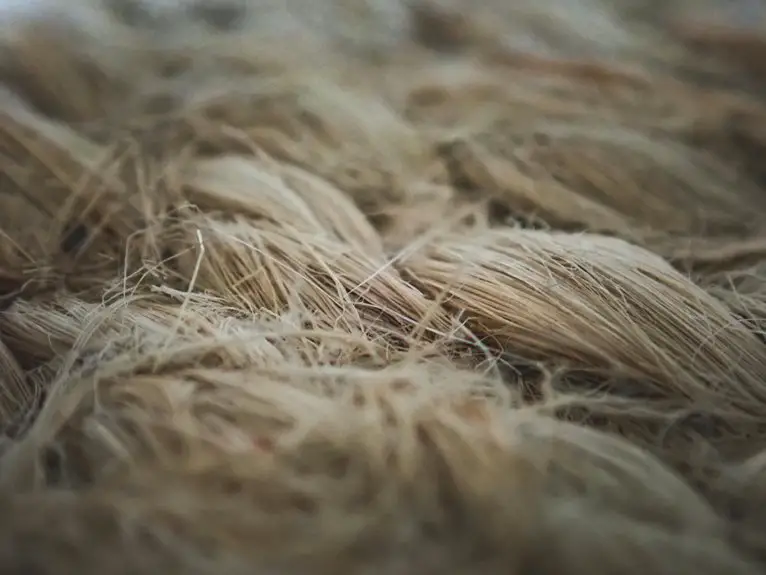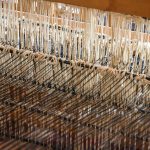You’re working with cellulose acetate, a fabric made by chemically modifying natural cellulose from plants like wood and cotton. This plant-based origin makes it biodegradable and eco-friendlier than synthetic materials. The process changes cellulose by adding acetyl groups, enhancing durability and versatility for textiles, film, and more. While it’s a sustainable choice, cellulose acetate has unique care needs and faces challenges like heat sensitivity. Exploring further reveals its manufacturing, benefits, and innovations shaping future fabrics.
Table of Contents
Key Takeaways
- Cellulose acetate is derived from cellulose, a natural polymer found abundantly in plants like wood, cotton, hemp, and flax fibers.
- The fabric is produced by chemically modifying cellulose with acetic acid, replacing hydroxyl groups with acetyl groups.
- Raw cellulose is extracted from renewable plant sources, making cellulose acetate a semi-synthetic, eco-friendly material.
- The acetylation process transforms natural cellulose into a flexible, durable fabric widely used in textiles and other industries.
- Cellulose acetate is biodegradable and has a smaller environmental footprint compared to fully synthetic fabrics made from petroleum.
What Is Cellulose Acetate?
Cellulose acetate is a versatile synthetic compound derived from cellulose, the natural polymer found in plant cell walls.
Cellulose acetate is a flexible synthetic material made by modifying natural cellulose from plant cell walls.
When you work with cellulose acetate, you’re handling a modified form of cellulose that’s been chemically treated with acetic acid. This process changes its properties, making it more durable and easier to shape than raw cellulose.
You’ll find it used in various products, from textiles and film to eyeglass frames and cigarette filters. Because it’s semi-synthetic, it combines the benefits of natural materials with enhanced performance.
When you touch cellulose acetate fabric, you experience a soft texture with good drape and color retention. It’s also biodegradable under the right conditions, making it a more eco-friendly option compared to many purely synthetic fibers.
Natural Sources of Cellulose
Although you mightn’t always see it, cellulose forms the structural backbone of many plants you encounter daily. It’s the most abundant organic polymer on Earth, giving plants their strength and rigidity.
When you explore natural sources of cellulose, you’ll find it mainly in:
- Wood – Trees like pines and oaks provide a rich cellulose source used in paper and fabric production.
- Cotton – Nearly pure cellulose fiber, cotton is essential for textiles due to its softness and breathability.
- Hemp and Flax – These plants offer strong, fibrous cellulose, often used for durable fabrics and ropes.
Recognizing these sources helps you understand where cellulose acetate, a versatile fabric material, originates, linking nature to everyday products.
The Chemical Structure of Cellulose Acetate
You’ll find that cellulose acetate’s unique properties come from its molecular composition and the acetylation process it undergoes.
By replacing some hydroxyl groups in cellulose with acetyl groups, its structure changes markedly.
Understanding this helps you see how these structural shifts impact its physical and chemical behavior.
Molecular Composition Overview
Understanding the chemical structure of cellulose acetate helps you grasp why it’s such a versatile material. At its core, cellulose acetate is derived from cellulose, a natural polymer made of glucose units linked in long chains.
When you look closer, the chemical makeup includes acetyl groups attached to these glucose units, altering its properties considerably.
Here’s what you should know about its molecular composition:
- Polymeric Backbone: The repeating glucose units form a sturdy chain, providing strength and flexibility.
- Acetyl Substitutions: Acetyl groups replace some hydroxyl groups, reducing water solubility and enhancing durability.
- Degree of Substitution (DS): This number indicates how many hydroxyl groups are replaced, directly affecting the material’s physical characteristics.
This combination makes cellulose acetate adaptable for various applications.
Acetylation Process Explained
Because cellulose itself isn’t very water-resistant, manufacturers chemically modify it through a process called acetylation to enhance its properties.
During acetylation, hydroxyl groups (-OH) in the cellulose molecules react with acetic anhydride. This reaction replaces some hydroxyl groups with acetyl groups (-COCH3), reducing cellulose’s affinity for water.
You’ll find that this modification changes the chemical structure, making cellulose acetate less hydrophilic and more durable. The degree of acetylation varies, influencing the final product’s characteristics like solubility and melting point.
By controlling this process, manufacturers tailor cellulose acetate for different applications, from textiles to film.
Understanding this chemical change helps you appreciate how a natural polymer transforms into a versatile, plant-based fabric with improved performance.
Structural Properties Impact
Although cellulose acetate originates from natural cellulose, its chemical structure changes considerably during acetylation, directly affecting its physical properties.
When you modify the hydroxyl groups to acetate groups, you alter how the molecules interact, which impacts flexibility, solubility, and durability. Understanding these changes helps you appreciate why cellulose acetate behaves differently from raw cellulose.
Here are three key structural impacts you should know:
- Hydrophobicity Increases – Replacing hydroxyl groups with acetyl groups reduces water attraction, making the material less absorbent.
- Thermoplasticity Emerges – The modified structure allows the polymer to soften when heated, enabling easy molding.
- Mechanical Strength Adjusts – Acetylation balances rigidity and flexibility, improving resistance to cracking but maintaining pliability.
These structural shifts define cellulose acetate’s unique qualities in textiles and plastics.
The Manufacturing Process of Cellulose Acetate
To make cellulose acetate, you start by preparing raw materials like purified cellulose.
Then, you carry out the chemical acetylation process, where cellulose reacts with acetic anhydride.
This step transforms cellulose into cellulose acetate, giving it its unique properties.
Raw Material Preparation
Preparing raw materials sets the foundation for producing high-quality cellulose acetate. When you start, you need to focus on selecting the right plant-based fibers, mainly cellulose from wood pulp or cotton linters.
Then, you refine these fibers to guarantee purity and consistency.
Here’s what you should do:
- Source quality cellulose: Choose fibers with minimal impurities to guarantee smooth processing.
- Clean and dry: Remove any dirt, oils, or moisture that could affect the final product’s texture and performance.
- Cut and grind: Break down fibers into uniform sizes to improve reaction efficiency during acetylation.
Chemical Acetylation Process
Once you have high-quality, refined cellulose fibers, you move on to the chemical acetylation process, where cellulose transforms into cellulose acetate. You’ll react cellulose with acetic anhydride and acetic acid, using sulfuric acid as a catalyst. This reaction replaces hydroxyl groups in cellulose with acetyl groups, changing its properties—making it more durable, flexible, and soluble.
Here’s what you can expect during this fascinating process:
| Step | Emotion Evoked |
|---|---|
| Reacting cellulose | Excitement for change |
| Catalyzing reaction | Awe at chemistry |
| Producing acetate | Satisfaction of creation |
This process is critical—it’s the moment cellulose becomes a versatile, plant-based fabric ready for shaping into fibers and films you use every day.
Environmental Benefits of Cellulose Acetate
Although synthetic plastics dominate many industries, cellulose acetate offers a greener alternative that you mightn’t have considered.
Derived from renewable plant sources, it reduces reliance on fossil fuels. When you choose cellulose acetate, you’re supporting a material that breaks down more easily in the environment, lessening plastic pollution.
Here are three key environmental benefits you’ll appreciate:
- Biodegradability: Unlike many plastics, cellulose acetate decomposes naturally, minimizing landfill waste.
- Renewable sourcing: It comes from cellulose found in plants, making it sustainable and reducing carbon footprint.
- Lower toxicity: Its production and disposal emit fewer harmful chemicals, promoting cleaner ecosystems.
Comparing Cellulose Acetate to Synthetic Fabrics
When you compare cellulose acetate to synthetic fabrics, you’ll notice one key difference: cellulose acetate comes from natural sources, while synthetics rely on petroleum.
This origin affects their environmental footprints, with cellulose acetate generally breaking down more easily.
Understanding these contrasts helps you make smarter choices for both style and sustainability.
Natural Vs Synthetic Origins
Understanding the origins of cellulose acetate helps you appreciate its unique place between natural and synthetic fabrics.
Unlike fully synthetic materials made from petrochemicals, cellulose acetate starts with cellulose, a natural polymer from plants. However, it undergoes chemical processing to become a semi-synthetic fiber, blending nature and lab work.
Here’s what sets it apart:
- Source: Derived from renewable plant fibers, not solely fossil fuels.
- Processing: Chemically modified to enhance durability and texture.
- Performance: Offers breathability closer to natural fibers but with synthetic fabric’s versatility.
Environmental Impact Differences
Since cellulose acetate originates from natural materials, it generally has a smaller environmental footprint than fully synthetic fabrics made from petrochemicals.
When you choose cellulose acetate, you’re opting for a fabric derived from renewable resources like wood pulp, which reduces reliance on fossil fuels.
Synthetic fabrics, such as polyester or nylon, require energy-intensive processes and release more greenhouse gases during production.
Plus, synthetic fibers often contribute to microplastic pollution when washed, harming aquatic ecosystems.
While cellulose acetate isn’t entirely impact-free—its manufacturing involves chemical treatments—you can still expect less environmental harm overall.
Applications of Cellulose Acetate in Textiles
Cellulose acetate plays an essential role in the textile industry due to its unique combination of durability, softness, and moisture resistance.
Cellulose acetate combines durability, softness, and moisture resistance, making it indispensable in textiles.
When you choose fabrics made from cellulose acetate, you benefit from versatility and comfort.
Here are three key applications you’ll find valuable:
- Apparel: It’s widely used in linings and lightweight garments because it feels smooth against your skin and drapes well.
- Home Furnishings: You’ll see it in curtains and upholstery, where its moisture resistance helps maintain fabric integrity.
- Specialty Textiles: It’s favored for theatrical costumes and vintage-style clothing due to its ability to mimic silk’s appearance without the high cost.
Durability and Care of Cellulose Acetate Fabrics
Although cellulose acetate fabrics offer a luxurious feel and attractive appearance, you’ll need to handle them with care to keep them looking their best. This fabric is sensitive to heat, moisture, and harsh chemicals, which can weaken the fibers or cause discoloration. When cleaning, always opt for gentle hand washing or dry cleaning. Avoid wringing or twisting to prevent damage. Proper storage, away from direct sunlight, helps maintain color and strength.
| Care Aspect | Recommendation |
|---|---|
| Washing | Hand wash or dry clean only |
| Drying | Air dry flat, avoid heat |
| Ironing | Use low heat setting |
| Storage | Store in a cool, dark place |
Follow these tips to extend the life of your cellulose acetate garments.
Innovations in Cellulose Acetate Production
Keeping your cellulose acetate fabrics in top condition highlights how delicate this material can be, which is why ongoing improvements in its production matter so much.
Maintaining cellulose acetate fabrics reveals their delicate nature and the importance of continual production advancements.
Innovations focus on making cellulose acetate more sustainable, durable, and versatile for your everyday use. Here are three key advancements you should know about:
- Bio-based raw materials: Manufacturers now use renewable plant sources more efficiently, reducing reliance on synthetic chemicals.
- Eco-friendly solvents: New processes replace harmful acetone with greener solvents, lowering environmental impact and improving safety.
- Enhanced fiber properties: Techniques like nanotechnology strengthen fibers, making your fabric more resistant to wear and tear without compromising softness.
These innovations not only improve the quality of cellulose acetate but also guarantee it aligns with your growing demand for sustainable, high-performance textiles.
Challenges in Using Cellulose Acetate
While cellulose acetate offers many benefits, you’ll encounter some challenges when using it. For starters, it’s sensitive to heat and moisture, which means you need to handle and care for it carefully to avoid warping or degradation.
It’s also less durable than synthetic fabrics, so it can wear out faster under heavy use or frequent washing. You might find that it’s prone to yellowing over time, especially when exposed to sunlight, which can affect its appearance.
Additionally, because cellulose acetate is derived from plant materials, its production involves chemical processes that can be environmentally taxing if not managed properly.
Future Trends in Plant-Based Fabrics
You’ve seen some of the hurdles that come with using cellulose acetate, but the future of plant-based fabrics looks promising.
Innovations are pushing this sustainable material to new heights, making it more durable, eco-friendly, and versatile. As you explore these trends, keep an eye on:
- Bio-based enhancements – Scientists are developing additives from natural sources to improve strength and moisture resistance without harming the environment.
- Recycling advancements – New methods enable better recovery and reuse of cellulose acetate, reducing waste and conserving resources.
- Blended fabrics – Combining cellulose acetate with other plant fibers creates textiles that balance comfort, durability, and sustainability.
Frequently Asked Questions
How Does Cellulose Acetate Fabric Feel Compared to Cotton or Silk?
You might think cellulose acetate feels just like cotton or silk, but it’s actually smoother and shinier than cotton, yet less soft and luxurious than silk. You’ll notice its silky feel with a slight crispness.
Can Cellulose Acetate Fabrics Be Dyed at Home?
You can dye cellulose acetate at home, but you’ll need a specific disperse dye and high heat to set the color. Regular fabric dyes won’t work well, so prepare for a careful process to avoid damage.
Is Cellulose Acetate Hypoallergenic for Sensitive Skin?
When it comes to sensitive skin, you’re in luck—cellulose acetate is generally hypoallergenic. You won’t get itchy or irritated easily, so it’s a safe bet if you want comfort without breaking out.
What Are Common Misconceptions About Cellulose Acetate Fabric?
You might think cellulose acetate is synthetic or harmful, but it’s plant-based and eco-friendly. Many assume it wrinkles easily or lacks durability, yet it’s actually strong and resists wrinkles better than some fabrics.
How Does Cellulose Acetate Fabric Handle Moisture and Sweat?
You want comfort, you want breathability—you want cellulose acetate fabric to handle moisture well. It absorbs sweat moderately but dries quickly, keeping you fresh and comfortable without clinging or feeling damp during daily wear or light activity.
- What Does “Cotton-Rich Percale” Mean on a Label? - July 15, 2025
- What Does a Percale Sheet Consist Of? A Breakdown of Weave and Fiber - July 15, 2025
- What Are Egyptian Cotton Percale Sheets? The Ultimate Luxury Explained - July 15, 2025







